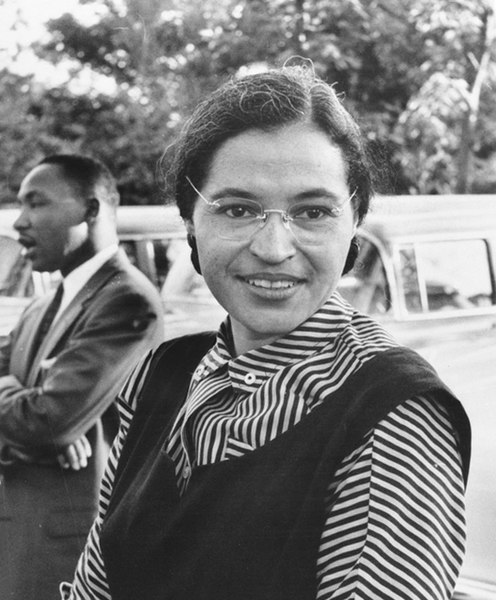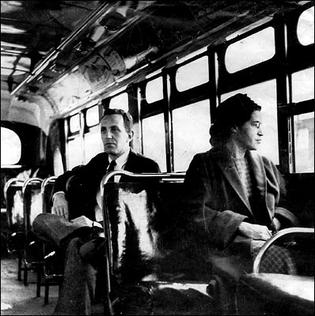Rosa Parks (1913-2005) was an iconic figure in the American Civil Rights Movement. Born in Tuskegee, Alabama, Parks became known for her courageous act of refusing to give up her seat to a white passenger on a segregated bus in Montgomery, Alabama, in 1955.
This act of civil disobedience sparked the Montgomery Bus Boycott, a mass protest against racial segregation on buses, and became a catalyst for change in the fight for civil rights.
Parks’ unwavering dedication to equality led to significant advancements in the struggle against racial discrimination.
Her legacy continues to inspire generations and serves as a reminder of the power of individual action in the pursuit of justice.
Timeline of Rosa Parks Life
1913: Rosa Louise McCauley is born on February 4th in Tuskegee, Alabama
Rosa Parks was born as Rosa Louise McCauley in Tuskegee, a small town in Alabama. She was the first child of James McCauley, a carpenter, and Leona Edwards McCauley, a teacher. Rosa had a younger brother named Sylvester.
1932: At the age of 19, Rosa marries Raymond Parks, a barber and civil rights activist
In 1932, at the age of 19, Rosa married Raymond Parks, who worked as a barber. Raymond was an active member of the National Association for the Advancement of Colored People (NAACP), a prominent civil rights organization.
Also Read: Facts About Rosa Parks
Through Raymond’s influence, Rosa became increasingly involved in civil rights activism and the struggle for racial equality.

1943: Rosa becomes a member of the Montgomery chapter of the NAACP
In 1943, Rosa Parks joined the Montgomery chapter of the NAACP, becoming an active member in the fight against racial discrimination. She served as the chapter’s secretary, which allowed her to work closely with civil rights leaders and activists in the community.
Parks was dedicated to challenging segregation and advocating for equal rights for African Americans.
Also Read: Accomplishments of Rosa Parks
During this period, Rosa Parks also attended the Highlander Folk School, an educational center in Tennessee that focused on civil rights and social justice issues. The school played a significant role in providing training and inspiration for activists during the Civil Rights Movement.
Rosa Parks’ early experiences, including her marriage to Raymond Parks and her involvement with the NAACP, laid the foundation for her later courageous act of resistance on the Montgomery bus, which would ultimately become a catalyst for change in the United States.
1955: On December 1st, Rosa Parks refuses to give up her seat to a white passenger on a segregated bus in Montgomery, Alabama
On that fateful day, Rosa Parks boarded a city bus in Montgomery, Alabama, and took a seat in the “colored” section. As the bus filled up, the driver ordered Parks and three other African American passengers to give up their seats for white passengers.
Also Read: Timeline of the Montgomery Bus Boycott
Parks refused to comply with the unjust segregation laws and made a courageous decision to stay seated. Her refusal led to her arrest by the Montgomery Police Department.
1955: Rosa’s arrest sparks the Montgomery Bus Boycott
Rosa’s arrest sparks the Montgomery Bus Boycott, a mass protest organized by the Montgomery Improvement Association (MIA), led by Dr. Martin Luther King Jr. The boycott lasts for 381 days and ends with a Supreme Court ruling that segregation on buses is unconstitutional.
News of Rosa Parks’ arrest spread quickly through the African American community in Montgomery. In response, local leaders and activists, including Dr. Martin Luther King Jr., organized the Montgomery Bus Boycott.
African Americans refused to ride the city buses in protest against segregation and discrimination. The boycott lasted for an astounding 381 days, during which African Americans utilized carpools, walked, or cycled to their destinations.
The boycott caught national attention, and Rosa Parks’ courageous act became a symbol of resistance against racial inequality. The movement faced intense resistance and threats from white supremacists, but the determination and perseverance of the activists led to a significant victory.
In 1956, the Supreme Court ruled in Browder v. Gayle that racial segregation on buses was unconstitutional, effectively ending bus segregation in Montgomery.

1956: Rosa and her husband Raymond Parks move to Detroit, Michigan
Following the Montgomery Bus Boycott and the subsequent legal victory, Rosa Parks and her husband, Raymond Parks, faced continued harassment and threats in Alabama. The couple decided to relocate to Detroit, Michigan, seeking a safer and more supportive environment.
In Detroit, Rosa Parks continued her activism and became involved in various civil rights causes. She worked as a secretary and receptionist for U.S. Representative John Conyers, Jr., who was a prominent advocate for civil rights. Parks remained committed to fighting for equality and justice throughout her life, even in her new home.
Rosa Parks’ refusal to give up her seat and the subsequent Montgomery Bus Boycott marked a turning point in the Civil Rights Movement. Her courageous act and the collective efforts of activists in Montgomery paved the way for further advancements in the fight against racial segregation and discrimination.
Rosa Parks’ name became synonymous with resistance and sparked a renewed determination in the struggle for civil rights.
1965: Rosa becomes a staff assistant to U.S. Representative John Conyers, Jr
In 1965, Rosa Parks began working as a staff assistant to U.S. Representative John Conyers, Jr. She served in this role for over two decades until her retirement in 1988.
During her time with Congressman Conyers, Parks focused on addressing issues such as racial equality, social justice, and civil rights legislation. Her position allowed her to continue advocating for causes she was passionate about on a national level.
1987: Rosa Parks and her husband found the Rosa and Raymond Parks Institute for Self-Development
In 1987, Rosa Parks and her husband Raymond Parks established the Rosa and Raymond Parks Institute for Self-Development. The organization aimed to empower young people and promote their personal growth and development.
Through educational programs, youth leadership training, and scholarships, the institute sought to inspire the next generation to carry forward the ideals of social justice and equality.
1999: President Bill Clinton awards Rosa Parks the Congressional Gold Medal
In 1999, Rosa Parks was awarded the Congressional Gold Medal, the highest civilian honor in the United States.
President Bill Clinton presented her with the medal during a ceremony held at the U.S. Capitol in recognition of her extraordinary contributions to civil rights and her role in shaping American history.
This prestigious award highlighted the significance of Rosa Parks’ bravery and her lasting impact on the nation.
2005: Rosa Parks passes away on October 24th at the age of 92 in Detroit, Michigan
Rosa Parks passed away on October 24, 2005, at the age of 92 in Detroit, Michigan. Her death sparked a period of mourning and reflection across the country.
Her funeral service, held at the Greater Grace Temple in Detroit, was attended by thousands of people, including civil rights leaders, politicians, and citizens who were inspired by her legacy.
Parks was interred at the Woodlawn Cemetery in Detroit, where she rests alongside her husband Raymond Parks.
Rosa Parks’ contributions to civil rights and her unwavering commitment to equality earned her immense respect and recognition both during her lifetime and posthumously. Her activism and bravery continue to inspire generations, and her name remains synonymous with the struggle for justice and equality.
